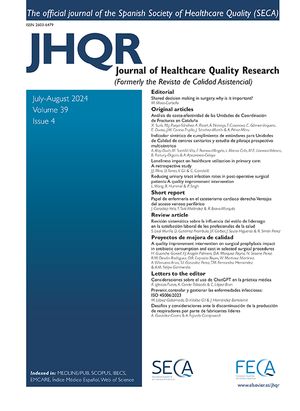Estudiar la utilidad clínica del cuestionario genérico de calidad de vida relacionada con la salud (CVRS) SF-36 en los servicios de asistencia sanitaria.
MétodoSe llevó a cabo un estudio descriptivo con 691 pacientes con distintos diagnósticos médicos reclutados en el ámbito de consultas externas de un hospital general. Los grupos diagnósticos fueron cáncer de pulmón (CP) y hematológico (CH), osteoartrosis de cadera (OAC), trastornos de la alimentación (TA) y enfermedad inflamatoria intestinal crónica (EIIC). Los pacientes incluidos en el estudio cumplimentaron el SF-36, un instrumento genérico de CVRS. Con los pacientes con OAC que iban a ser operados de prótesis de cadera (PC) fue realizado un estudio de seguimiento antes y después de la intervención.
ResultadosLos pacientes con TA presentaban puntuaciones bajas en las áreas mentales, funcionamiento social y rol físico. Aquellos con CP contaban con valores bajos en todas las áreas del SF-36, que eran menores en las físicas y ligeramente más bajas que en los pacientes con CH. Los pacientes con OAC presentaban un impacto importante en las áreas físicas, principalmente en el área de dolor corporal; las mejoras tras la intervención eran mayores en las áreas físicas. Aquellos pacientes con EIIC, evidenciaban afección principal en el área de salud general.
ConclusionesEl SF-36 es capaz de discriminar entre distintas enfermedades. Estos resultados apoyan su validez discriminante como un indicador para la evaluación de resultados de procedimientos médicos entre centros y entre grupos de pacientes.
To study the usefulness of a generic health-related quality of life (HRQoL) instrument, the SF-36.
MethodA descriptive study was performed in 691 patients with different clinical problems recruited from the outpatient departments of a general hospital. The diagnostic groups selected were lung and hematological cancer, hip osteoarthritis, eating disorders and chronic inflammatory bowel disease (CIBD). Recruited patients were asked to complete the SF-36, a generic HRQoL questionnaire. A follow-up study was performed in patients with hip osteoarthritis before and after total joint hip replacement.
ResultsPatients with eating disorders scored lower in the mental domains, social functioning and physical role. Patients with lung cancer had low values in all HRQoL domains. Their scores were lower in the physical areas, and slightly lower than those in patients with hematological cancer. Patients with hip osteoarthritis showed significant effects in the physical areas, mainly in the bodily pain domain. Improvement after surgery was greater in the physical domains. In patients with CIBD mainly the general health domain was affected.
ConclusionsThe SF-36 was able to discriminate among different clinical problems. These results support its discriminative validity as an indicator for the evaluation of the outcomes of medical procedures among centers and patient groups.






